Abstract
Transport is an area that is developing at a tremendous pace. This development applies not only to electric and hybrid cars appearing more and more often on the road but also to those of an autonomous or semi-autonomous nature. This applies to both passenger cars and vans. In many different publications, you can find a description of a number of benefits of using automated guided vehicles (AGV) for logistics and technical tasks, e.g., in the workplace. An important aspect is the use of knowledge management and machine learning, i.e., artificial intelligence (AI), to design these types of processes. An important issue in the construction of autonomous vehicles is the IT connection of sensors receiving signals from the environment. These signals are data for deep learning algorithms. The data after IT processing enable the decision-making by AI systems, while the used machine learning algorithms and neural networks are also needed for video image analysis in order to identify and classify registered objects. The purpose of this article is to present and verify a mathematical model used to respond to vehicles’ demand for a transport service under set conditions. The optimal conditions of the system to perform the transport task were simulated, and the efficiency of this system and benefits of this choice were determined.
1. Introduction
Modern humans are more connected than ever in history and for this purpose they use various means of communication and transport. Huge development took place in the transport sector, covering all modes of transport: air sea, rail, and road [1,2,3,4,5,6,7]. In road transport, this development included not only vehicles [8,9,10] but also the development of road infrastructure [11,12,13,14] and progress in the field of fuels and energy [15,16,17,18]. Among the research on fuels, the large share of gaseous fuels, such as LPG [19,20], natural gas [21], CNG [22], LNG [23,24] hydrogen feed systems [25], PEM fuel cells [26], and others [27,28,29], should be emphasized. In recent years, there has been a huge development in the field of internal combustion engines [30,31,32,33,34,35,36], the existing power supply systems for spark ignition engines [37,38,39,40], diesel engines [30,31,41,42,43], battery electric vehicles [9,44,45,46,47], and hybrid systems [48,49,50,51]. A completely different issue is autonomous vehicles (AV), which constitute a separate, quite extensive part of the transport sector and hence the great interest and multifaceted research in this field [52,53,54,55,56,57,58,59]. AV are supposed to bring many benefits to society [59]. Many scientists [52,60,61,62,63] believe that the implementation of AV will bring about big changes in mobility and accessibility, travel patterns, transport safety, and energy efficiency and hence emissions, employment, data availability, and management in business models. In the publications, the authors pay special attention to the benefits of using automated guided vehicles for logistics and technical tasks in the workplace [64,65,66,67]. The transport sector plays an important role in the economic development of any country, but unfortunately, it contributes to the depletion of natural resources, consumes significant amounts of energy, and is the main source of environmental pollution [68,69,70,71]. To meet these challenges, various modern methods, technologies and software are used, which ensure the improvement of production efficiency, minimization of costs, minimization of production time, and transport tasks [72,73,74].
For example, References [75,76] studied the scale of heavy metal pollution in areas along expressways and highways in Poland. Skrucany and Gnap [77] present the study on impact of the road and rail cargo transport on air pollution in the Slovak Republic. Transport also contributes to a huge number of tragic road traffic accidents. Many national [78,79,80,81] and foreign [82,83,84] publications have been devoted to the issues of road traffic safety.
In order to improve road safety, reduce the negative effects of transport on the natural environment, and improve the flow of traffic, attempts were made to change the transport system. The answer to these challenges is the creation of a new system based on communication between vehicles, infrastructure, and the environment, which aims to introduce fully autonomous vehicles into use. The experiences related to vehicles used in the AGV production processes, which are oriented in a closed space, respond to the demand, and provide a specific transport service in an autonomous manner, are helpful here.
This article presents the ideas of AV and the use of artificial intelligence in the management of this type of vehicle. The paper presents a mathematical model used to respond to vehicles’ demand for a transport service under set conditions. The optimal conditions of the system to perform the transport task were simulated, and the efficiency of this system was determined.
2. Artificial Intelligence in Vehicles
Artificial intelligence (AI) in transport is associated with autonomous vehicles. Such a vehicle, equipped with sensors, radars, lidars, or cameras and GPS locators, is able to move independently in the vicinity of traditional cars or AV. The most recent example of such a vehicle is the T-POD from Einride. Communication with the vehicle is based on communication in the 5G infrastructure, and the Nvidia Drive platform was used to control the surrounding environment. AI uses data from route planning systems, traffic information, cameras, radar, and three-dimensional lidars (Light Detection and Ranging). Intelligent software solutions help solve the disadvantages of traditional radar signal processing in distinguishing between moving and stationary objects. As a result, the vehicle can more quickly and accurately determine and evaluate the behavior of objects on the roads [85]. An interesting solution is proposed by Pugi et al. [86] in terms of implementing fuzzy logic for vehicle control a vehicle in reduced traction conditions of an electric vehicle.
The mentioned AI is a field that combines computer science and stable data sets, and its feature is the ability to solve problems. AI also includes the sub-domains of Machine Learning and Deep Learning [87,88]. They include algorithms whose task is to create expert systems that forecast or classify on the basis of input data. Deep learning automates much of the feature extraction process, eliminating the need for human intervention. Machine learning can import raw unstructured data (e.g., text, images) and automatically define a hierarchy of characteristics that distinguish data categories from one another [89].
Due to the use of sensors for collecting various data, dedicated modules are used for each type of sensor. This approach allows for parallel data processing and thus faster decision making. Each unit receiving the signal from the sensor can use a different AI algorithm and then transfer its results to higher-order circuits or a central processing computer [90]. AI technology works by interacting with sensors and uses their readings in real time. AV therefore operate in a real-time system, and their electronic systems must generate deterministic results in the time domain. The necessary AI processing power and the amount of memory needed to perform calculations make it difficult to implement in a CPU equipped with CPUs with limitations in the amount of memory and speed. Distributed systems require a large amount of data sent from sensors. Sensors that are hierarchically linked or designed in a fail-safe system in an oversized system, the so-called IT redundancy, may cause delays in data transmission, which in turn interferes with decision-making by AI systems [90].
An important issue in the construction of AV is the IT connection of sensors receiving signals from the environment. These signals are data for deep learning algorithms. After IT processing, they enable decision-making by AI systems. Machine learning algorithms and neural networks are also used for video image analysis to identify and classify recorded objects. Thanks to greater predictability of road hazards, the use of AI systems can contribute to the improvement of road traffic safety by reducing the number of accidents and reducing the number of fatalities. The use of AV will therefore allow us to get closer to the “vision 0”, where there are no victims of road traffic accidents. There have been many publications on the subject of “vision 0” of road traffic accidents, among which it is worth mentioning the following studies [78,83,84].
The main tasks of AI built into an AV are route planning, interaction with the sensor system, and interpretation of sensor data. Route planning is important in order to optimize the trajectory of a vehicle and to create patterns of behavior in certain road situations. This is to reduce delays and avoid traffic jams [91]. Planning is a dynamic task that must take into account stochastic information about, for example, resignation from servicing the point that reported such a necessity or servicing the point by another vehicle and the need to assign a new task for a given vehicle.
After planning the path, the vehicle is able to navigate on road conditions, detecting objects: pedestrians, bicycles, and traffic lights. Object detection algorithms in AI enable human-like behavior. The difficulty level of the task increases as road and weather conditions change. The reason for many accidents with tested vehicles was that the simulation environment differs from the real conditions, and the AI software may react unpredictably when it obtains incomplete or erroneous data [92]. Another task of AI is prediction, i.e., the use of monitoring and modeling to determine the state of traffic conditions, possible traffic disturbances, and vehicle or infrastructure failure, i.e., an attempt to predict future problems, not problems that already exist. Algorithms can use on-board and external data to make decisions about future events. The machine learning algorithms used for this task are classification algorithms like logistic regression, support vector machines, and random forest algorithm [93].
AI algorithms implemented in AV and tested in city traffic are often opposed by constructors who point out AI as a dead end of technological development. AI algorithms based on a neural network perform tasks without understanding the process they control [91].
A compromise solution is the use of hybrid solutions that combine AI with traditional control algorithms. As indicated in [94], the advantage of using a hybrid solution is the possibility of a quick analysis of the causes of accidents or collisions involving an AV. Information is obtained as to why the decision was made and the alternative was rejected. This is due to the fact that the behavior of the vehicle in response to a certain signal should be described not with one algorithm but with several complementary ones. Such action counteracts, for example, misinterpretation of the situation when, for example, there is an unreadable sign on the road, or an incorrect analysis of the video signal was performed.
3. Route Planning and Control Algorithms
In order for a vehicle equipped with AI to move safely in real road conditions, the AI must be equipped with behavior patterns. These schemas are a derivative of the learning process and the acquisition of knowledge necessary to make decisions. The above process begins with testing the vehicle on routes in an isolated environment where under supervision it is possible to carry out tests by introducing changes to the route layout or disturbances on the route (closed route, change of the point reporting the need for service).
The Vehicle Routing Problem is combinatorial and is classified as an NP-complete problem. Finding the optimal solution becomes more complicated with the increase of the area on which the points reporting the need for service are located and the increase in the number of these points. The search for a solution is carried out by dividing the task into problems of a lower order. This activity covers two topics:
- The division of the set of all points reporting the need for service or destinations into regions, each of which will be assigned to one vehicle.
- Determining the order of service within the area.
In the issue of determining service routes, there is a concept of the point/destination assignment problem. It is created when none of the vehicles has preliminary information about the target but has a built-in map on which all points within its range are marked. The vehicles share points / targets between themselves so that the journey time is minimal.
For the implementation of the above tasks, heuristic algorithms are also used, such as the Bellman–Ford and Dijkstra algorithms [95]. For these algorithms to work, the vehicle must send its location continuously. Localization is carried out with the use of sensors, e.g., GPS, as well as simultaneous location and mapping techniques (SLAM). SLAM is applied when there is no GPS availability, i.e., in tunnels or in underground and closed spaces [96].
Heuristic models are also used in solving problems related to the formation of congestion [97], where vehicles heading to different points, choosing the shortest route, will move along the same sections of the road network. This will turn the shortest route into an overloaded route which can only be traveled at the minimum speed. The solution to this problem was presented in the article [98], where a multi-criteria simulation from which a set of independent route selection strategies can be obtained. The road network is presented in the form of a graph with nodes marking the beginning or the end of the route. A set of vehicles is assigned to the graph, as well as a set of pairs of start–destination nodes between which the vehicles travel. The solution begins with greedy vehicle allocation on the shortest route and uses a combinatorial search for alternative routes not only in terms of their length but also travel time. The described algorithm of route selection can be supplemented with deterministic models taking into account delays at intersections, describing those caused by cross traffic [99] or cascading multi-link congestion [100].
The use of classical algebraic methods in order to find the shortest route while minimizing the travel time may cause that in some cases the exponential equations that are the solution provide results in the form of unrealistic long travel times in the case of a large concentration of vehicles on road sections. We receive the so-called “trapping the simulated vehicle in perpetual traffic jam”. A way to eliminate these errors is to model congestion with queuing when the traffic load exceeds a certain threshold, usually 2.5 times the link capacity [98].
The above-described algebraic methods based on combinatorics and heuristic methods are the most commonly used classic tools to solve the problem of route selection, the order of handling, and the method of initiating a transport task. On the other hand, evolutionary algorithms [101] are used for additional variables influencing the movement of the vehicle. These can be signal control [102,103] or changes in the transport network arrangement [104].
4. Modeling Example
The basic task of mapping the route, the results of which can be used as input data to AI algorithms, can be solved on the set of N points making up the transport system which is served by m vehicles [105]. In such a situation, each point sends a request for service with the intensity λ. The intensity of servicing these points by vehicles is μ. Additional assumptions are made regarding the handling time. The sequences of time intervals between successive reporting of points to be processed are independent of each other. The service time is a random variable, and with m vehicles, each of them works independently of each other.
The theory of Mark’s random systems is used to calculate the capacity of the transport system, the average length of the queue to be serviced, and the average number of notifications [105]. It assumes that the transport system is single-channel, in which the request stream λ is described by the Poisson distribution, while the service time is subject to the exponential distribution. The service follows the firs-in-first-out (FIFO) rule, the idea of which is that the first free vehicle is sent to the point that first requested transport service. System states are saved, which are created by introducing successive iterations regarding the number of vehicles and the number of service requests. The initial states of the system are marked as:
- E0—all vehicles free, no tasks to be serviced,
- E1—one vehicle busy, one notification in the system,
- E2—two vehicles seized, two reports in the system.
Between the states from E1 to E2, the system is routed through the request stream with the intensity (N−1)λ because in the E1 state, one service point has already sent the request, so N−1 points have the possibility of reporting.
Successive states of the system can be saved in the form:
- Em—m of vehicles occupied, m notification in the system,
- Ej—m of vehicles occupied, j-m reports in the queue for service,
- EN—m of vehicles occupied, N points waiting for service, N-m requests waiting for service.
Between the states E0 to EN, the system is guided by the request stream with the intensity Nλ [58].
The dynamics of the transport system can be described by the system of differential equations [106]:
The correctness of the saved equations is determined by the normalizing condition:
In the steady state, the equations of dynamics of the transport system take the form:
The probability of the system being in a steady state is calculated using the following formulas:
In order to simplify further equations, the parameter ρ, is introduced, which is the result of the quotient of the intensity of reports λ by the points, and the intensity of servicing these points by the vehicles μ:
The probability of po takes the form of the equation:
Probability that r points reports a service necessity, were 1 ≤ r ≤ N:
Average number of requests waiting in the queue:
The average number of vehicles serving the points:
The average number of notifications in the system:
The average time the notifications remain in the system:
The average time the notifications were in the queue:
The results of the simulation of sending vehicles to service points are presented below (Figure 1 and Figure 2). They were carried out for N = 100 points requiring service and for m = 30 vehicles. Taking into account the state 0, 101 states were included in the analysis. The simulation time was set at t = 2000 time units. In this case, the unit of time is the second. The time interval was selected in such a way that it is often used by other researchers in simulations. For example, in the work of Yang et al. [107], the autonomous vehicle was tested on a selected road section in about 30 min, and the obtained data were then used for simulation.
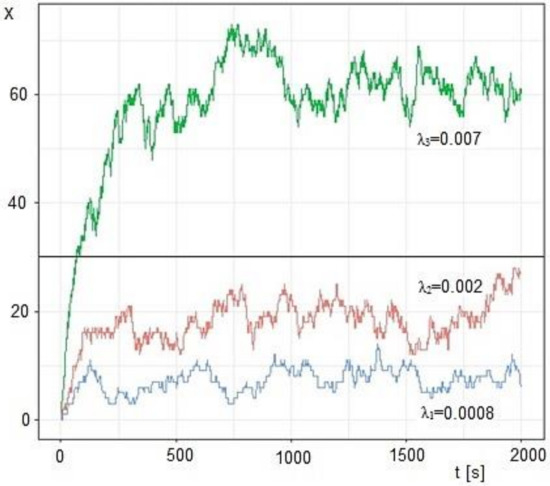
Figure 1.
Simulation of transition between states in consecutive moments of time t = 2000 (starting from state 0—no pending reports), for μ = 0.009 and values λ1 = 0.0008, λ2 = 0.002, λ3 = 0.007.
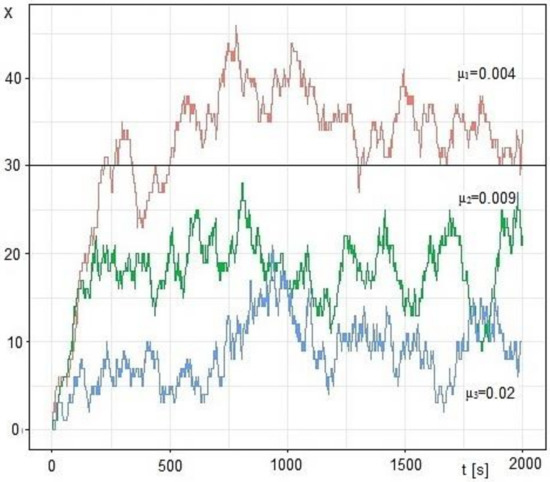
Figure 2.
Simulation of transition between states in consecutive moments of time t = 2000 (starting from state 0—no pending reports), for μ1 = 0.004, μ2 = 0.009 and μ3 = 0.02, λ = 0.05.
In Figure 1, successive moments of time are marked on the OX axis. The status, i.e., the number of notifications at the current moment, is marked on the OY axis. The horizontal line intersecting the OY axis in the value 30 means the number of vehicles m servicing the system; therefore, if the state is currently above this line, the vehicles cannot keep up with the order handling. Such a situation occurs in the case of λ3 = 0.007, where the system becomes inefficient.
In Figure 2, on the OX axis, successive moments of time are marked, and on the OY axis, the state in which the system is at a given moment. The horizontal line crossing the OY axis in the value 30 represents the number of vehicles m serving the system. As before, if the state is currently above this line, the vehicles cannot keep up with the handling of orders. This situation occurs very quickly for μ1 after about 200 s.
Figure 3 shows the probability distribution of individual states in the steady state. Individual states are marked on the OX axis (from 0 to 101), and on the OY axis, the probability of staying in these states in a steady state. The number of points to be served is N = 100, and m = 30 vehicles.
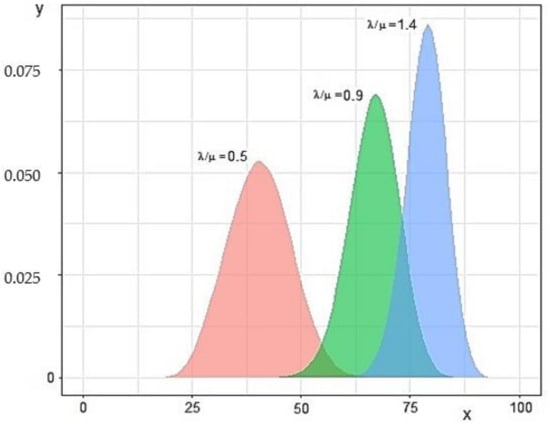
Figure 3.
Probability distribution of individual states in the steady state, for λ/μ = 0.5, λ/μ = 0.9, λ/μ = 1.4. ().
The analysis of sending vehicles to service points was supplemented with the economic aspect of the issue, i.e., vehicle maintenance costs, profits from servicing the point, and costs related to not servicing the point [108,109]. Such analyzes for the actual conditions of a transport company from the courier industry are presented [110,111,112,113]. Further profit simulations are shown in Figure 4, Figure 5, Figure 6, Figure 7, Figure 8 and Figure 9.
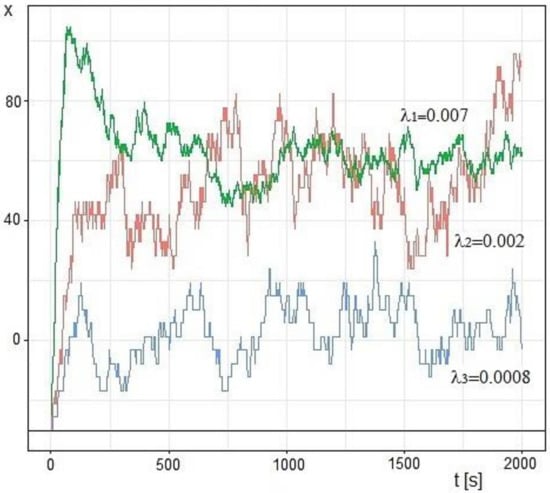
Figure 4.
Simulation of gains α for the values λ1 = 0.0008, λ2 = 0.002, and λ3 = 0.007 and μ = 0.009. The horizontal line crossing the OY axis in the value (−30) determines the fixed cost of maintaining the vehicles.
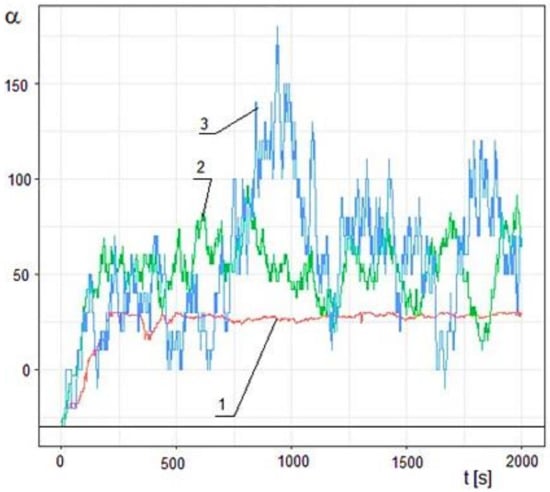
Figure 5.
Simulation of gains α for the values μ1 = 0.004, μ2 = 0.009, and μ3 = 0.02 and λ = 0. The horizontal line crossing the OY axis in the value (−30) determines the fixed cost of maintaining the vehicles.
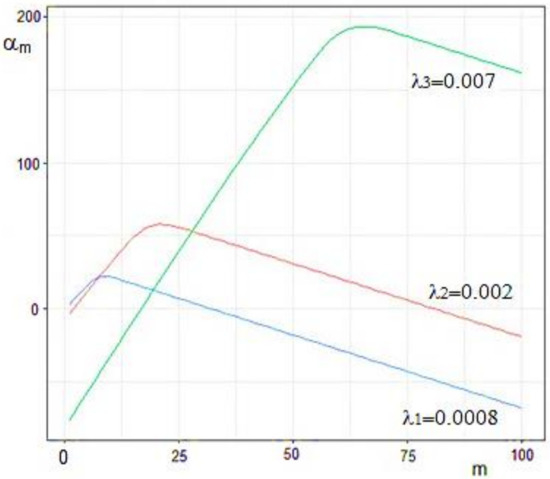
Figure 6.
Simulation of average gains αm for various numbers of vehicles m for the following data: λ1 = 0.0008, λ2 = 0.002, and λ3 = 0.007 and μ = 0.009. The OY axis represents Average Profit.
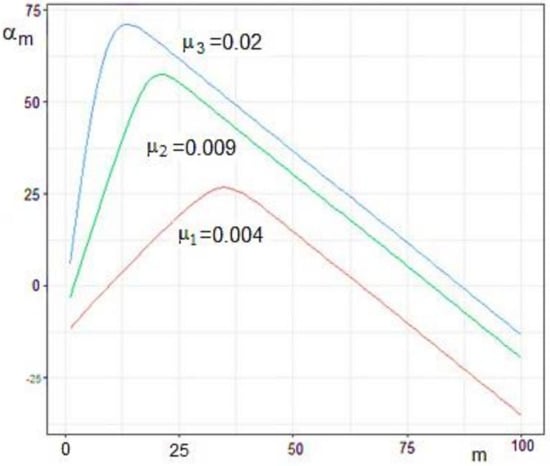
Figure 7.
Simulation of the average gains αm for various numbers of m vehicles for the following data: μ1 = 0.004, μ2 = 0.009, and μ3 = 0.02 and λ = 0.002. The OY axis represents Average Profit.
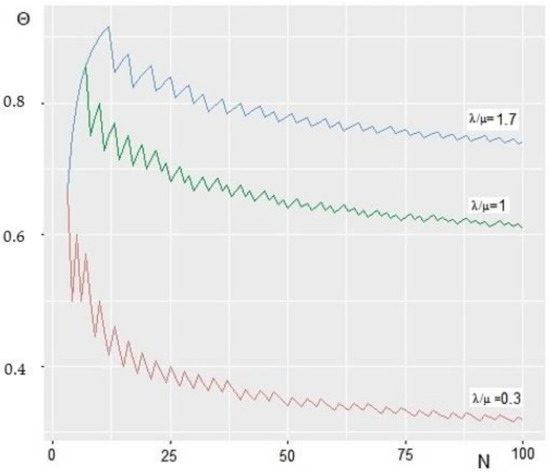
Figure 8.
Simulation of the optimal number of m vehicles for the value λ/μ = 0.3, λ/μ = 1, and λ/μ = 1.7 ().
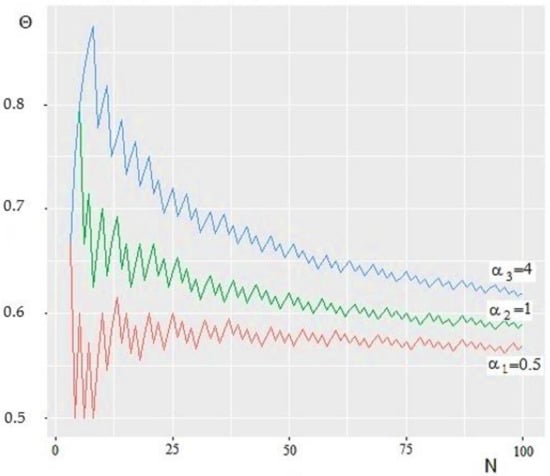
Figure 9.
Simulation of the optimal number of m vehicles for the value α1 = 0.5, α2 = 1, and α3 = 4.
The economic aspect (profit marked as α) is the difference between the revenue from servicing points and the cost of maintaining vehicles and the cost of not handling applications. Profit at each single moment is calculated according to the following assumptions.
where
- α(t) is the profit at time t;
- δ—unit cost of maintaining the vehicle at a single moment (we assumed the value 1);
- m—number of vehicles;
- μ—notification service intensity (such part of the entire notification is processed in a single step by a single vehicle);
- β—profit resulting from a fully handled request (500 was assumed);
- p(t)—system status, number of notifications in the system;
- min(m, p(t))—the number of notifications handled at the moment (if p(t) ≥ m, then only m notifications are handled because we have only m vehicles; if p(t) < m, all notifications are supported);
- λ—intensity of the appearance of a new notification (such a part of the cost of not handling the notification is incurred in a single step);
- γ—profit resulting from a completely unhandled report (200 was assumed);
- max(0, p(t)–m)—the number of unhandled reports at the moment (if m ≥ p(t), then all reports are handled; if m < p(t), then there are unsupported reports in the system p(t)–m tickets).
It was assumed that the revenue from servicing the point is equal to 500 monetary units. Due to the fact that in the mathematical model it is difficult to unequivocally determine at which point the point was actually served, each of them was multiplied by μ (probability of serving the point). The number of points served is the lower of the following numbers: the number of available cars (when there are not enough vehicles to service) and the state (when there are not enough notifications).
Another assumption is the cost of an unhandled call, assumed as 200 monetary units. In this case, each point was multiplied by λ (the probability of the report occurrence). The number of unhandled reports is the difference between the stock and the number of vehicles (if positive). Moreover, the cost of maintaining vehicles is also included, which is equal to the value of 1 monetary unit multiplied by the number of vehicles at any time.
The simulations in the graphs presented in Figure 4 and Figure 5 were carried out for the number of vehicles m = (1; 30).
Figure 6 and Figure 7 show the profit simulation for the number of vehicles m = (1; 100) and answer what number of vehicles is optimal from the profit point of view, depending on the parameters λ and μ.
The averaged profit value according to the rules for calculating the economic aspect was averaged for all 2000 simulation time moments. The calculation methodology was identical to that presented in Figure 4 and Figure 5, and the difference was that the number of vehicles was increased by m = 100.
The difference between profit (Figure 4 and Figure 5) and average profit (Figure 6 and Figure 7) can be explained in a descriptive way. The process of sending cars to service points is dynamic, i.e., the profit changes over time. In order to calculate the efficiency of service for a given number of vehicles, a certain value was calculated for a simulation lasting t = 2000 time moments. This value determines what profit is given by the given number of kept vehicles, i.e., the profit for 2000 times has practically been averaged.
The graphs in Figure 8 and Figure 9 show regression curves giving information on what part of the number of points served should be the number of vehicles in order to maximize the profit depending on the number of points served in steady state. In Figure 8, the simulation concerns different values of λ/μ, while in Figure 9, it concerns different values of the profit α resulting from servicing the point and the loss resulting from not servicing it.
The regression was calculated from the equation:
Table 1 shows the parameters for the regression evaluation.

Table 1.
The regression evaluation.
The calculations were carried out according to the methodology presented below: profit from handling one order and loss from not handling one order are equal to 5000 monetary units; the cost of maintaining one vehicle in one turn is 200 monetary units; the intensity of service is .
For N = 500 service points, the regression value is as follows:
The optimal number of vehicles sent to service points is the following:
The simulation of profits showed that for 500 service points, the optimal number of cars sent to service points is greater than assumed in the test and should amount to 106 vehicles. In the adopted economic model, it was assumed that the profit on servicing one order is the same as the loss on not handling one order.
5. Conclusions
Contemporary solutions in vehicles are focused on supporting classic systems (traditional human-controlled vehicles) with additional functions supporting drivers and implementing fully autonomous systems (from the 4th level of autonomy). This fact applies not only to the road communication infrastructure but also to those automation solutions that are currently being introduced inside enterprises, e.g., internal warehouses. Contemporary humans are strongly connected to this process and their role is assigned to process management. Certainly, in the near future, the implementation of AV will bring major changes in mobility and accessibility, travel patterns, transport safety, and energy efficiency and, consequently, emissions, employment, data availability, and management in business models.
In this study, simulations of sending m = 30 vehicles to N = 100 points served by these vehicles were carried out. Usually, the system was efficient, i.e., in two states, it was always possible to execute orders, while in one state the system quickly became inefficient (in the first case, it took place after approx. 80 s, in the second at 200 s).
Then, economic profit tests were carried out for such planned tasks, which affect the financial condition of the company due to the execution of orders. In this case, simulations were carried out for two assumptions about an increased number of service points for 30 and 100 vehicles. Research for 500 service points showed that the optimal number of cars sent to service points should be 106, so it is greater than the assumed number by 6 vehicles. Similarly, shortages of vehicles occurred in the test, assuming m = 30 vehicles.
The main contribution of this work is to simulate a model that can potentially help in solving transport tasks, especially in a situation where in the coming years it is expected that cars, both passenger cars and vans, will be supported by autonomic systems. This can be helpful both in the implementation of similar practical tasks and in the creation of more advanced mathematical models by scientists. The general conclusion is that the transport system is very heterogeneous, and it is difficult to fit an ideal model because orders are executed very quickly and some require much longer processing time.
Author Contributions
Conceptualization, J.C., A.N. and A.D.; methodology, J.C., A.N., A.D. and T.K.; software, T.K.; validation, J.C. and M.S.; formal analysis, J.C., A.N., A.D., T.K. and M.S.; investigation, A.N., A.D. and T.K; resources, J.C., A.N., A.D. and M.S.; data curation, J.C., A.N. and T.K.; writing—original draft preparation, J.C., A.N., A.D., T.K. and M.S.; writing—review and editing, J.C., A.N., A.D. and T.K.; visualization, J.C., A.N. and A.D; supervision, J.C. and A.N.; project administration, J.C. and A.N. All authors have read and agreed to the published version of the manuscript.
Funding
The project/research was financed in the framework of the project Lublin University of Technology—Regional Excellence Initiative, funded by the Polish Ministry of Science and Higher Education (contract no. 030/RID/2018/19).
Data Availability Statement
Not applicable.
Conflicts of Interest
The authors declare no conflict of interest.
References
- Matušková, S.; Červinka, M.; Kodym, O. Service marketing of some regional airports. International Multidisciplinary Scientific GeoConference Surveying Geology and Mining Ecology Management. SGEM 2017, 17, 783–790. [Google Scholar]
- Moroza, N.; Hudenko, J.; Jurgelane-Kaldava, I. The development of the Baltic Sea Region as a centre of global logistics: The situation report and future prospects. Lect. Notes Netw. Syst. 2021, 195, 678–690. [Google Scholar]
- Danis, J.; Dolinayova, A.; Cerna, L.; Zitricky, V. Impact of the economic situation in the Slovak Republic on performances of railway transport. Period. Polytech. Transp. Eng. 2019, 47, 118–123. [Google Scholar] [CrossRef]
- Gerhátová, Z.; Zitrický, V.; Klapita, V. Analysis of customs processing of wagon consignment at Slovakia-Ukraine border. LOGI-Sci. J. Transp. Logist. 2021, 12, 58–66. [Google Scholar] [CrossRef]
- Hurtova, I.; Sejkorova, M.; Verner, J.; Kucera, M. Preference and area coordination of public transport in modern city. Eng. Rural Dev. 2018, 17, 2085–2091. [Google Scholar]
- Bartuska, L.; Stopka, O.; Lizbetin, J. Methodology for determining the traffic volumes on urban roads in the Czech Republic. In Proceedings of the 19th International Scientific Conference on Transport Means, Kaunas, Lithuania, 22–23 October 2015; pp. 215–218. [Google Scholar]
- Poliak, M.; Tomicova, J.; Hammer, J.; Droździel, P. Free access to the road transport market as a condition for the sustainability of road transport functionality in the European Union. In Proceedings of the 2020 XII International Science-Technical Conference AUTOMOTIVE SAFETY, Kielce, Poland, 21–23 October 2020. [Google Scholar]
- Brumercik, F.; Lukac, M.; Krzysiak, Z.; Krzywonos, L. Model of integrated transportation system. Commun. Sci. Lett. Univ. Žilina 2017, 19, 23–26. [Google Scholar] [CrossRef]
- Čulík, K.; Štefancová, V.; Hrudkay, K.; Morgoš, J. Interior heating and its influence on electric bus consumption. Energies 2021, 14, 8346. [Google Scholar] [CrossRef]
- Pugi, L.; Giglioli, M.; Berzi, L.; Locorotondo, E.; Pretto, A. Simulation and design of a kit for the electrification of a light tricycle truck. Int. J. Heavy Veh. Syst. 2020, 27, 278–302. [Google Scholar] [CrossRef]
- Gnap, J.; Senko, Š.; Kostrzewski, M.; Brídziková, M.; Cződörová, R.; Říha, Z. Research on the relationship between transport infrastructure and performance in rail and road freight transport—A case study of Japan and selected European Countries. Sustainability 2021, 13, 6654. [Google Scholar] [CrossRef]
- Hájnik, A.; Harantová, V.; Kalašová, A.; Čulík, K. Traffic modeling of intersections on Vajnorská street in Bratislava. Transp. Probl. 2021, 16, 29–40. [Google Scholar] [CrossRef]
- Kalašová, A.; Čulík, K.; Poliak, M.; Otahálová, Z. Smart parking applications and its efficiency. Sustainability 2021, 13, 6031. [Google Scholar] [CrossRef]
- Sommerauerova, D.; Chocholac, J.; Urbanova, K. Sustainable green city logistic solution for the Prague agglomeration and retail chain. Perner’s Contacts 2020, 15, 2. [Google Scholar] [CrossRef]
- Górski, K.; Sander, P.; Longwic, R. The assessment of ecological parameters of diesel engine supplied with mixtures of canola oil with n-hexane. IOP Conf. Ser. Mater. Sci. Eng. 2018, 421, 042025. [Google Scholar] [CrossRef]
- Hunicz, J.; Matijosius, J.; Rimkus, A.; Kilikevicius, A.; Kordos, P.; Mikulski, M. Efficient hydrotreated vegetable oil combustion under partially premixed conditions with heavy exhaust gas recirculation. Fuel 2020, 268, 117350. [Google Scholar] [CrossRef]
- Kubica, G.; Flekiewicz, M.; Marzec, P. Selected aspects of the use of gaseous fuels blends to improve efficiency and emission of SI engine. Transp. Probl. 2019, 14, 95–103. [Google Scholar] [CrossRef]
- Orynycz, O.; Wasiak, A. The effect of external transport on energetic efficiency of biodiesel production. J. Ecol. Eng. 2017, 18, 57–62. [Google Scholar] [CrossRef][Green Version]
- Fabiś, P.; Flekiewicz, M. Optimalisation of the SI engine timing advance fueled by LPG. Sci. J. Sil. Univ. Technol. Ser. Transp. 2021, 111, 33–141. [Google Scholar] [CrossRef]
- Szpica, D. Comparative analysisi of the chaaracteristics of a low-pressure gas-phase injector. Flow Meas. Instrum. 2017, 58, 74–86. [Google Scholar] [CrossRef]
- Ding, S.L.; Song, E.Z.; Yang, L.P.; Litak, G.; Ma, X.Z. Investigation on nonlinear dynamic characteristics of combustion instability in the lean-burn premixed natural gas engine. Chaos Solitons Fractals 2016, 93, 99–110. [Google Scholar] [CrossRef]
- Biały, M.; Wendeker, M.; Magryta, P.; Czyż, Z.; Sochaczewski, R. CFD Model of the Mixture Formation Process of the CNG Direct Injection Engine; SAE Technical Paper 2014-01-2575; SAE International: Warrendale, PA, USA, 2014. [Google Scholar]
- Jurkovic, M.; Kalina, T.; Skrucany, T.; Gorzelanczyk, P.; L’uptak, V. Environmental impacts of introducing LNG as alternative fuel for urban buses-case study in Slovakia. Promet-Traffic Transp. 2020, 32, 837–847. [Google Scholar] [CrossRef]
- Song, H.; Ou, X.; Yuan, J.; Yu, M.; Wang, C. Energy consumption and greenhouse gas emissions of diesel/LNG heavy-duty vehicle fleets in China based on a bottom-up model analysis. Energy 2017, 140, 966–978. [Google Scholar] [CrossRef]
- Małek, A.; Taccani, R.; Kasperek, D.; Hunicz, J. Optimization of energy management in a city bus powered by the hydrogen fuel cells. Commun. Sci. Lett. Univ. Žilina 2021, 23, E56–E67. [Google Scholar] [CrossRef]
- Chen, R.; Qin, Y.; Du, Q.; Peng, J. Effects of Clamping Force on the Operating Behavior of PEM Fuel Cell; SAE Technical Paper; SAE International: Warrendale, PA, USA, 2018. [Google Scholar]
- Hunicz, J.; Mikulski, M.; Shukla, P.C.; Gęca, M.S. Partially premixed combustion of hydrotreated vegetable oil in a diesel engine: Sensitivity to boost and exhaust gas recirculation. Fuel 2022, 307, 121910. [Google Scholar] [CrossRef]
- Labaj, J.; Barta, D. Unsteady flow simulation and combustion of ethanol in diesel engines. Komunikacie 2006, 8, 27–37. [Google Scholar] [CrossRef]
- Zdziennicka, A.; Szymczyk, K.; Jańczuk, B.; Longwic, R.; Sander, P. Surface, volumetric, and wetting properties of oleic, linoleic, and linolenic acids with regards to application of canola oil in diesel engines. Appl. Sci. 2019, 9, 3445. [Google Scholar] [CrossRef]
- Droździel, P. The influence of the vehicle work organization conditions on the engine start-up parameters. Eksploat. Niezawodn.-Maint. Reliab. 2008, 37, 72. [Google Scholar]
- Eliasz, J.; Osipowicz, T.; Abramek, K.F.; Matuszak, Z.; Mozga, L. Fuel pretreatment systems in modern CI engines. Catalysts 2020, 10, 696. [Google Scholar] [CrossRef]
- Hunicz, J.; Filipek, P.; Kordos, P.; Gęca, M.S.; Rybak, A. Transient combustion timing management in controlled auto-ignition engine based on ion current signal. In Proceedings of the 2017 3rd IEEE International Conference on Control Science and Systems Engineering (ICCSSE), Beijing, China, 17–19 August 2017; pp. 351–354. [Google Scholar]
- Kukuca, P.; Barta, D.; Labuda, R.; Gechev, T. Engine with Unconventional Crank Mechanism FIK1. MATEC Web Conf. 2018, 244, 03004. [Google Scholar]
- Kuranc, A.; Słowik, T.; Wasilewski, J.; Szyszlak-Bargłowicz, J.; Stoma, M.; Šarkan, B. Emission of Particulates and Chosen Gaseous Exhausts Components During a Diesel Engine Starting Process. Farm Machinery and Processes Management in Sustainable Agriculture, 9th International Scientific Symposium, Lublin, Poland, 22–24 November 2017; Lorencowicz, E., Uziak, J., Huyghebaert, B., Eds.; ULS: Lublin, Poland, 2017; pp. 210–215. [Google Scholar]
- Osipowicz, T.; Abramek, K.F.; Barta, D.; Droździel, P.; Lisowski, M. Analysis of possibilities to improve environmental operating parameters of modern compression-ignition engines. Adv. Sci. Technol. Res. J. 2018, 12, 206–213. [Google Scholar] [CrossRef]
- Sejkorova, M.; Sarkan, B.; Verner, J. Efficiency assessment of fuel borne catalyst. MATEC Web Conf. 2017, 134, 00051. [Google Scholar] [CrossRef]
- Figlus, T.; Liščák, Š. Assessment of the vibroactivity level of SI engines in stationary and non-stationary operating conditions. J. Vibroengineering 2014, 16, 1349–1359. [Google Scholar]
- Mieczkowski, G.; Szpica, D.; Borawski, A.; Diliunas, S.; Pilkaite, T.; Lesis, V. Application of smart materials in the actuation system of a gas injector. Materials 2021, 14, 6984. [Google Scholar] [CrossRef] [PubMed]
- Osipowicz, T.; Abramek, K.F.; Matuszak, Z.; Jaśkiewicz, M.; Ludwinek, K.A.; Łagowski, P. The concept of annular channels application on the spraying nozzle needle of modern fuel injector in the aspect of combustion process improvement. In Proceedings of the 2018 XI International Science-Technical Conference Automotive Safety, Žastá, Slovakia, 18–20 April 2018. [Google Scholar]
- Pukalskas, S.; Kriaučiūnas, D.; Rimkus, A.; Przybyła, G.; Droździel, P.; Barta, D. Effect of hydrogen addition on the energetic and ecologic parameters of an SI engine fueled by biogas. Appl. Sci. 2021, 11, 742. [Google Scholar] [CrossRef]
- Aulin, D.; Klymenko, O.; Falendysh, A.; Kletska, O.; Dizo, J. Improvement of diesel injector nozzle test techniques. IOP Conf. Ser. Mater. Sci. Eng. 2020, 985, 012031. [Google Scholar] [CrossRef]
- Kamiński, M.; Budzyński, P.; Hunicz, J.; Józwik, J. Evaluation of changes in fuel delivery rate by electromagnetic injectors in a common rail system during simulated operation. Eksploat. Niezawodn. Maint. Reliab. 2021, 23, 352–358. [Google Scholar] [CrossRef]
- Punov, P.; Gechev, T.; Mihalkov, S.; Podevin, P.; Barta, D. Experimental study of multiple pilot injection strategy in an automotive direct injection diesel engine. MATEC Web Conf. 2018, 234, 03007. [Google Scholar] [CrossRef][Green Version]
- Csonka, B.; Havas, M.; Csiszár, C.; Földes, D. Operational methods for charging of electric vehicles. Period. Polytech. Transp. Eng. 2020, 48, 369–376. [Google Scholar] [CrossRef]
- Hurtová, I.; Sejkorová, M.; Verner, J. Experience operating a trolleybus equipped with traction batteries nLTO. In Proceedings of the Transport Means-Proceedings of the International Conference, 21st International Scientific Conference TRANSPORT MEANS, Kaunas University of Technology, Kaunas, Lithuania, 20–22nd September 2017; pp. 242–247. [Google Scholar]
- Małek, A.; Marciniak, A. The use of deep recurrent neural networks to predict performance of photovoltaic system for charging electric vehicles. Open Eng. 2021, 11, 377–389. [Google Scholar] [CrossRef]
- Sendek-Matysiak, E.; Rzedowski, H.; Skrucany, T. Electromobility in Poland and Slovakia. Benchmarking of electric vehicles for 2019. Commun. Sci. Lett. Univ. Zilina 2020, 22, 35–45. [Google Scholar] [CrossRef]
- Dizo, J.; Blatnický, M.; Semenov, S.; Mikhailov, E.; Kostrzewski, M.; Droździel, P.; Štastniak, P. Electric and plug-in hybrid vehicles and their infrastructure in a particular European region. Transp. Res. Procedia 2021, 55, 629–636. [Google Scholar] [CrossRef]
- Hamza, K.; Laberteaux, K.P.; Chu, K.C. On modeling the cost of ownership of plug-in vehicles. World Electr. Veh. J. 2021, 12, 39. [Google Scholar] [CrossRef]
- Prajwowski, K.; Gołębiewski, W.; Lisowski, M.; Abramek, K.F.; Galdynski, D. Modeling of working machines synergy in the process of the hybrid electric vehicle acceleration. Energies 2020, 13, 5818. [Google Scholar] [CrossRef]
- Šarkan, B.; Gnap, J.; Kiktova, M. The importance of hybrid vehicle in urban traffic in terms of environmental impact. Arch. Automot. Eng. Arch. Motoryz. 2019, 85, 115–122. [Google Scholar] [CrossRef]
- Bartuska, L.; Labudzki, R. Research of basic issues of autonomous mobility. Transp. Res. Procedia 2020, 44, 356–360. [Google Scholar] [CrossRef]
- Gkartzonikas, C.; Gkritza, K. What have we learned? A review of stated preference and choice studies on autonomous vehicles. Transp. Res. Part C Emerg. Technol. 2019, 98, 323–337. [Google Scholar] [CrossRef]
- Moravcik, L. Typové schválenie autonómnych (samojazdiacich) vozidiel. Perner’s Contacts 2020, 15, 2. [Google Scholar]
- Podkowski, K.A.; Okruch, Ł. Fatigue tests and numerical analyses of the PAWO autonomous electric vehicle. Arch. Automot. Eng. Arch. Motoryz. 2021, 93, 39–58. [Google Scholar]
- Siqueira Silva, D.; Csiszár, C.; Földes, D. Autonomous vehicles and urban space management. Sci. J. Sil. Univ. Technol. Ser. Transp. 2021, 110, 169–181. [Google Scholar] [CrossRef]
- Stączek, P.; Pizoń, J.; Danilczuk, W.; Gola, A. A digital twin approach for the improvement of an autonomous mobile robots (AMR’s) operating environment—A case study. Sensors 2021, 21, 7830. [Google Scholar] [CrossRef] [PubMed]
- Varecha, D.; Kohár, R.; Lukáč, M. Theoretical study of heat conduction in the multi-disc brake integrated into the drive wheel AGV during braking. Bull. Pol. Acad. Sci. Tech. Sci. 2021, 69, e136718. [Google Scholar]
- Czech, P.; Turoń, K.; Barcik, J. Autonomous vehicles: Basic issues. Sci. J. Sil. Univ. Technol. Ser. Transp. 2018, 100, 15–22. [Google Scholar] [CrossRef]
- Charness, N.; Yoon, J.S.; Souders, D.; Stothart, C. Yehnert, C. Predictors of attitudes toward autonomous vehicles: The roles of age, gender, prior knowledge, and personality. Front. Psychol. 2018, 9, 2589. [Google Scholar] [CrossRef] [PubMed]
- Das, S.; Sekar, A.; Chen, R.; Kim, H.C.; Wallington, T.J.; William, E. Impacts of autonomous vehicles on consumers time-use patterns. Challenges 2017, 8, 32. [Google Scholar] [CrossRef]
- Himmetoglu, S.; Kilic, L.O. Safety issues in fully autonomous cars: A Turkish perspective. In Proceedings of the 23rd International Scientific Conference on Transport Means 2019, Palanga, Lithuania, 2–4 October 2019; pp. 131–134. [Google Scholar]
- Stopka, O. Modeling the delivery routes carried out by automated guided vehicles when using the specific mathematical optimization method. Open Eng. 2020, 10, 166–174. [Google Scholar] [CrossRef]
- Schockenhoff, F.; König, A.; Koch, A.; Lienkamp, M. Customer-relevant properties of autonomous vehicle concepts. Procedia CIRP 2020, 91, 55–60. [Google Scholar] [CrossRef]
- Pettigrew, S.; Fritschi, L.; Norman, R. The potential implications of autonomous vehicles in and around the workplace. Int. J. Environ. Res. Public Health 2018, 15, 1876. [Google Scholar] [CrossRef] [PubMed]
- Kłosowski, G.; Gola, A.; Thibbotuwawa, A. Computational intelligence in control of AGV multimodal systems. IFAC-Pap. 2018, 51, 1421–1427. [Google Scholar] [CrossRef]
- Seidlová, A.; Šourek, D.; Kučera, T. Technological limits for the use of Automated Guided Vehicles in intralogistic systems. In Proceedings of the 23rd International Conference on Transport Means, Palanga, Lithuania, 2–4 October 2019; pp. 338–342. [Google Scholar]
- Agarwal, A.; Kaddoura, I. On-road air pollution exposure to cyclists in an Agent-Based simulation framework. Period. Polytech. Transp. Eng. 2020, 48, 117–125. [Google Scholar] [CrossRef]
- Sun, L.; Zhang, T.; Liu, S.; Wang, K.; Rogers, T.; Yao, L.; Zhao, P. Reducing energy consumption and pollution in the urban transportation sector: A review of policies and regulations in Beijing. J. Clean. Prod. 2021, 285, 125339. [Google Scholar] [CrossRef]
- Verner, J.; Sejkorová, M.; Veselík, P. Volatile organic compounds in motor vehicle interiors under various conditions and their effect on human health. Sci. J. Sil. Univ. Technol. Ser. Transp. 2020, 107, 205–216. [Google Scholar] [CrossRef]
- Čorňák, Š.; Jelinek, J.; Droppa, P. Possibilities of quality and degradation of operating fluids. In Proceedings of the 23rd International Conference on Transport Means, Palanga, Lithuania, 2–4 October 2019; pp. 182–185. [Google Scholar]
- Balog, M.; Dupláková, D.; Szilágyi, E.; Mindas, M.; Knapčíková, L. Optimization of Time Structures in Manufacturing Management by using Scheduling Software Lekin. TEM J. 2016, 5, 319–323. [Google Scholar]
- Duplakova, D.; Teliskova, M.; Duplak, J.; Torok, J.; Hatala, M.; Steranka, J.; Radchenko, S. Determination of Optimal Production Process Using Scheduling and Simulation Software. Int. J. Simul. Model. 2018, 17, 609–622. [Google Scholar] [CrossRef]
- Grznár, P.; Gregor, M.; Krajčovič, M.; Mozol, Š.; Schickerle, M.; Vavrík, V.; Ďurica, L.; Marschall, M.; Bielik, T. Modeling and Simulation of Processes in a Factory of the Future. Appl. Sci. 2020, 10, 4503. [Google Scholar] [CrossRef]
- Słowik, T.; Szyszlak-Barglowicz, J.; Zając, G.; Piekarski, W. Limiting the environmental impact of road infrastructure through the use of roadside vegetation. Pol. J. Environ. Stud. 2015, 24, 1875–1879. [Google Scholar] [CrossRef]
- Szyszlak-Barglowicz, J.; Słowik, T.; Zając, G.; Piekarski, W. The content of heavy metals in the drainage ditches by communication routes. Rocz. Ochr. Srodowiska 2013, 15, 2309–2323. [Google Scholar]
- Skrucany, T.; Gnap, J. Energy intensity and greenhouse gases production of the road and rail cargo transport using a software to simulate the energy consumption of a train. Commun. Comput. Inf. Sci. 2014, 471, 263–272. [Google Scholar]
- Jamroz, K.; Kustra, W.; Budzynski, M.; Zukowska, J. Pedestrian protection, speed enforcement and road network structure the key action for implementing Poland’s Vision Zero. Transp. Res. Procedia 2016, 14, 3905–3914. [Google Scholar] [CrossRef]
- Matuszak, Z.; Jaśkiewicz, M.; Więckowski, D.; Stokłosa, J. Remarks to the reliability assessment and to human actions-especially car driver. MATEC Web Conf. 2017, 134, 00036. [Google Scholar] [CrossRef][Green Version]
- Szumska, E.; Frej, D.; Grabski, P. Analysis of the causes of vehicle accidents in Poland in 2009-2019. LOGI-Sci. J. Transp. Logist. 2020, 11, 76–87. [Google Scholar] [CrossRef]
- Tarkowski, S.; Rybicka, I. Distraction of the driver and its impact on road safety. Logi 2019—Horizons of Autonomous Mobility in Europe. Edited by: Stopkova, M., Bartuska, L., Stopka, O. Transp. Res. Procedia 2020, 44, 196–203. [Google Scholar] [CrossRef]
- Ágoston, G.; Madlenák, R. Road safety macro assessment model: Case study for Hungary. Period. Polytech. Transp. Eng. 2021, 49, 89–92. [Google Scholar] [CrossRef]
- Kristianssen, A.C.; Andersson, R.; Belin, M.A.; Nilsen, P. Swedish Vision Zero policies for safety—A comparative policy content analysis. Saf. Sci. 2018, 103, 260–269. [Google Scholar] [CrossRef]
- Zwetsloot, G.I.J.M.; Kines, P.; Ruotsala, R.; Drupsteen, L.; Merivirta, M.L.; Bezemer, R.A. The importance of commitment, communication, culture and learning for the implementation of the Zero Accident Vision in 27 companies in Europe. Saf. Sci. 2017, 96, 22–32. [Google Scholar] [CrossRef]
- Sztuczna Inteligencja w Transporcie? Available online: https://tsl-biznes.pl/newsy/sztuczna-inteligencja-w-transporcie (accessed on 20 November 2020).
- Pugi, L.; Grasso, F.; Pratesi, M.; Cipriani, M.; Bartolomei, A. Design and preliminary performance evaluation of a four wheeled vehicle with degraded adhesion conditions. Int. J. Electr. Hybrid Veh. 2017, 9, 1–32. [Google Scholar] [CrossRef]
- Liu, H.L.; Taniguchi, T.; Tanaka, Y.; Takenaka, K.; Bando, T. Visualization of driving behavior based on hidden feature extraction by using deep learning. IEEE Trans. Intell. Transp. Syst. 2017, 18, 2477–2489. [Google Scholar] [CrossRef]
- Yang, S.; Wang, W.; Liu, C.; Deng, W. Scene understanding in deep learning-based end-to-end controllers for autonomous vehicles. IEEE Trans. Syst. Man Cybern. Syst. 2019, 49, 53–63. [Google Scholar] [CrossRef]
- Sztuczna Inteligencja (AI). Available online: https://www.ibm.com/pl-pl/cloud/learn/what-is-artificial-intelligence (accessed on 20 November 2020).
- Harizow, A. The Role of Artificial Intelligence in Autonomous Vehicles July 15, 2020. Available online: https://www.embedded.com/the-role-of-artificial-intelligence-in-autonomous-vehicles/ (accessed on 30 November 2021).
- Abduljabbar, R.; Dia, H. Applications of artificial intelligence in transport: An overview. Sustainability 2019, 1, 189. [Google Scholar] [CrossRef]
- Khayyam, H.; Javadi, B.; Jalili, M.; Jazar, R. Artificial intelligence and internet of things for autonomous vehicles. In Nonlinear Approaches in Engineering Applications; Springer International Publishing: Berlin/Heidelberg, Germany, 2019; pp. 39–68. [Google Scholar]
- Prytz, R. Machine Learning Methods for Vehicle Predictive Maintenance Using Off-Board and On-Board Data; Halmstad University: Halmstad, Sweden, 2014; Volume 9, 32p. [Google Scholar]
- Teodorovic, D.; Lucic, P. Schedule synchronization in public transit by fuzzy ant system. Transp. Plan. Technol. 2005, 28, 47–76. [Google Scholar] [CrossRef]
- Bugała, M. Algorithms applied in autonomous vehicle systems. Szybkobiene Pojazdy Gasienicowe 2018, 50, 119–138. [Google Scholar]
- Cadena, C.; Carlone, L.; Carrillo, H.; Latif, Y.; Scaramuzza, D.; Neira, J.; Reid, I.; Leonard, J. Past, present, and future of simultaneous localization and mapping: Towards the robust-perception age. IEEE Trans. Robot. 2016, 32, 309–1332. [Google Scholar] [CrossRef]
- Misztal, W. The impact of perturbation mechanisms on the operation of the SWAP heuristic. Arch. Automot. Eng. Arch. Motoryz. 2019, 86, 27–39. [Google Scholar]
- Moran, N.; Pollack, J. Route assignment for Autonomous Vehicles. International Conference on Swarm Intelligence, ANTS 2016. Lect. Notes Comput. Sci. 2016, 9882, 265–272. [Google Scholar] [CrossRef]
- Jeihani, M.; Lawe, S.; Connolly, J.P. Improving traffic assignment model using intersection delay function. In Proceedings of the 47th Annual Transportation Research Forum, New York, NY, USA, 23–25 March 2006. [Google Scholar]
- Ji, Y.; Geroliminis, N. Modelling congestion propagation in urban transportation networks. In Proceedings of the 12th Swiss Transport Research Conference, Locarno, Switzerland, 2–4 May 2012. [Google Scholar]
- Beni, G.; Wang, J. Swarm intelligence in cellular robotic systems, Proceed. In NATO Advanced Workshop on Robots and Biological Systems; Springer: Berlin/Heidelberg, Germany, 1989. [Google Scholar]
- Turky, A.M.; Ahmad, M.S.; Yusoff, M.Z.M.; Sabar, N.R. Genetic algorithm application for traffic light control. In Information Systems: Modeling, Development, and Integration; Yang, J., Ginige, A., Mayr, H.C., Kutsche, R.D., Eds.; UNISCON 2009; Lecture Notes in Business Information Processing; Springer Science & Business Media: Berlin/Heidelberg, Germany, 2009; Volume 20, pp. 115–120. [Google Scholar] [CrossRef]
- Medina, J.J.S.; Moreno, M.J.G.; Royo, E.R. Evolutionary computation applied to urban traffic optimization. In Advances in Evolutionary Algorithms; IntechOpen: London, UK, 2008. [Google Scholar] [CrossRef]
- Schweitzer, F.; Ebeling, W.; Rose, H.; Weiss, O. Optimization of road networks using evolutionary strategies. Evol. Comput. 1997, 5, 419–438. [Google Scholar] [CrossRef] [PubMed]
- Nieoczym, A.; Caban, J.; Dudziak, A.; Stoma, M. Autonomous vans-the planning process of transport tasks. Open Eng. 2020, 10, 18–25. [Google Scholar] [CrossRef]
- Filipowicz, B. Modele Stochastyczne w Badaniach Operacyjnych; WNT: Warszawa, Poland, 1996; 328p. [Google Scholar]
- Yang, L.; Zhao, C.; Lu, C.; Wei, L.; Gong, J. Lateral and longitudinal driving behavior prediction based on improved deep belief network. Sensors 2021, 21, 8498. [Google Scholar] [CrossRef] [PubMed]
- Čejka, J.; Stopka, O. Effective Solutions to the Transport Distribution of Material by the Mayer Method. Adv. Sci. Technol. Res. J. 2018, 12, 177–183. [Google Scholar] [CrossRef]
- Kampf, R.; Stopka, O.; Bartuska, L.; Zeman, K. Circulation of vehicles as an important parameter of public transport efficiency. In Proceedings of the 19th International Scientific Conference on Transport Means, Kaunas, Lithuania, 22–23 October 2015; pp. 143–146. [Google Scholar]
- Droździel, P.; Komsta, H.; Krzywonos, L. An analysis of costs of vehicle repairs in a transportation company. Part II. Transp. Probl. 2012, 7, 5–11. [Google Scholar]
- Madleňák, R.; Štefunko, J. The optimization approach of postal transportation network based on uncapacitated fixed charge location model in conditions of Slovak Republic. Transp. Probl. 2015, 10, 35–43. [Google Scholar] [CrossRef][Green Version]
- Madleňáková, L.; Madleňák, R.; Droździel, P.; Kurtev, I. Layers and processes in the model of technological postal system. Transp. Telecommun. 2015, 16, 353–360. [Google Scholar] [CrossRef]
- Lazarević, D.; Dobrodolac, M.; Švadlenka, L.; Stanivuković, B. A model for business performance improvement: A case of the postal company. J. Bus. Econ. Manag. 2020, 21, 564–592. [Google Scholar] [CrossRef]
Publisher’s Note: MDPI stays neutral with regard to jurisdictional claims in published maps and institutional affiliations. |
© 2022 by the authors. Licensee MDPI, Basel, Switzerland. This article is an open access article distributed under the terms and conditions of the Creative Commons Attribution (CC BY) license (https://creativecommons.org/licenses/by/4.0/).